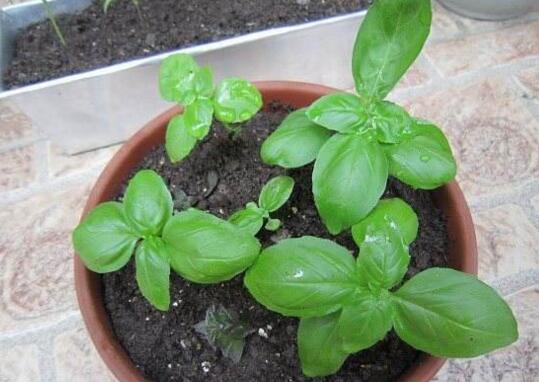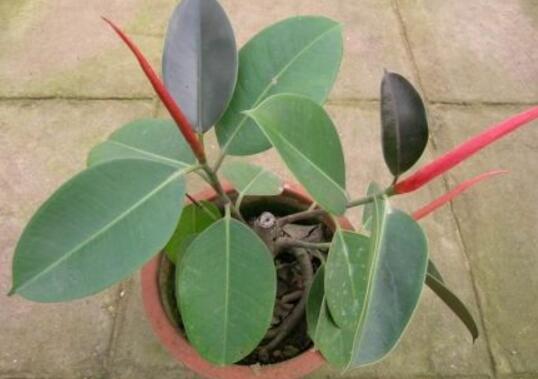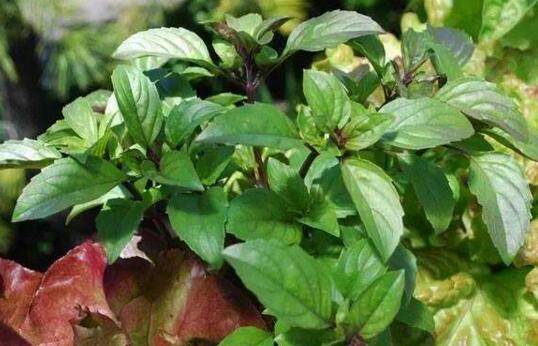How to raise basil, basil breeding methods and precautions/temperature light is critical
Although basil leaves have many effects and functions, in order for these benefits to be fully exerted, it is necessary to ensure that basil grows healthily. Because basil is sensitive to temperature, it needs to master certain skills when breeding, so how to raise basil? Let's take a look at basil farming methods and precautions.
Basil growing environment

Before understanding how basil is raised, you need to have a preliminary understanding of its suitable growth environment. Basil is sensitive to temperature, it grows rapidly in warm, dry environments, but is not cold-resistant, in addition, it is more resistant to drought than moisture, likes fertile and well-drained soil, and generally requires light.
How to raise basil
1. Soil requirements
Basil prefers fertile soil. When cultivating, humus soil and sandy soil are the best. Garden soil, river sand, etc. can be used. If potted culture, vermiculite, peat soil, etc. can be used to make matrix.
2. Temperature requirements
Basil is more afraid of cold plants, it likes warm environment, the most suitable temperature is between 15-28 degrees, so in spring, summer and autumn, its growth will be faster, but in winter need to ensure that the temperature is above 5 degrees, to avoid plants being frozen.
3. Lighting conditions
In basil breeding methods and precautions, basil requirements for light is sufficient sunlight, it is a kind of sun-loving plants, if the lack of light will lead to leaf color dim, growth will become slow, so usually management should put it in bright or full light place.
4, watering method
Watering should make the soil dry, because basil likes dry environment, its drought resistance is strong, usually watering 3-4 days once, do not let the soil too dry can, in addition to the high temperature in summer when the need to spray water often, other times as little as possible to spray water to the leaves, to avoid excessive humidity.
5, pest control
The main pests that harm basil are aphids, leaf miners, snails, etc., while the disease has fungal wilt disease, and the prevention and control method is mainly to do a good job of environmental sanitation at ordinary times, do not let the environment lack light, temperature is too low, humidity is too high, and pests should be treated with drugs in time.
Basil breeding methods and precautions
1. The soil does not accumulate water
When watering, do not pour too much at once, as long as the upper and lower parts of the soil are wet, do not let the roots soak in water, easy to cause root rot phenomenon. At the same time, ensure that the soil drainage is good, to avoid the rainy season when the water can not be discharged in time.
2. No lack of light
Basil leaves are green to give full play to its value, and to do so requires sufficient light, so do not let the environment lack light, especially if basil is not placed in a room with neither scattered light nor light, otherwise basil will soon wither and die.
3, the environment should be ventilated
One way to maintain environmental hygiene is to ventilate well, so that air circulation can avoid the breeding of germs and harmful microorganisms. If basil is always in an airtight environment, its chances of pests and diseases will increase exponentially, and its health hazards will be huge.
Cultivation methods and precautions of mesona oleracea Chinese scientific name mesona oleracea
Mesona chinensis Benth.
Also known as immortal grass, immortal frozen, immortal grass
kingdom planta
Phylum Angiospermum
Class Dicotyledonous
Synpetalaria
OPHILIFORMES
Labiaceae
Jacorolezzo
Basil
It belongs to the genus Mesona
seed jelly grass
Distribution area Taiwan, Zhejiang, Jiangxi, Guangdong, Guangxi in southern China
Cold powder grass, also known as: fairy grass, fairy frozen, fairy grass, for labiaceae plants, the lower part of the stem prostrate, the upper upright, leaves ovate or ovate oblong, apex slightly blunt, the base gradually contracted into a handle, the edge has small serrations, both sides have sparse long hair; born in the upper part of the inflorescence leaves smaller, bract like, ovate to inverted triangular, shorter flowers, the base often with pale purple, when the fruit falls off. Racemes weak, flowers small, whorled, calyx small, campanulate, 2-lipped, upper lip 3-lobed, lower lip entire, fruiting or tubular, recurved, with longitudinal veins and transverse wrinkles; corolla reddish, upper lip broad, entire or toothed, lower lip long elliptic, depressed; stamens 4, filaments prominent; pistil 1, style 2-lobed; disk expanded on one side. Nutlets elliptic. Late autumn flowering. Distribution in southern China.
1. Morphological characteristics
Herbs, erect or creeping. Stems 15-100 cm tall, branched or less branched, stems and branches quadrangular, sometimes sulcate, deciduous villous or setose. Leaves narrowly ovoid to broadly ovoid or suborbicular, 2-5 cm long, 0.8-2.8 cm wide, smaller on branchlets, apex acute or obtuse, base acute, obtuse or sometimes rounded, margin with or shallow or deep serrate, papery or submembranous, both surfaces setose or pilose, or hairy only along lower veins, or becoming glabrous, lateral veins 6-7 pairs, slightly raised below flat or retuse with middle rib above; petiole 2-15 mm long, spreading pilose. Cymes numerous, forming interrupted or subcontinuous terminal racemes, this inflorescence 2-10 (13) cm long, erect or obliquely upward, shortly pedunculated; bracts rounded or rhombo-ovoid, sparsely lanceolate, slightly longer than or shorter than flowers, with short or long caudate apices, usually colored; pedicels fine, 3-4(5) mm long, shortly hairy. Calyx flowers clock-shaped, 2-2.5 mm long, densely white sparsely pilose, veins inconspicuous, 2-lipped, upper lip 3-lobed, middle lobe extra large, apex acute or obtuse, lateral lobes small, lower lip entire, occasionally emarginate, calyx tubular or urn-tubular in fruit, 3-5 mm long, 10-veined and most transverse veins extremely conspicuous, forming pits between them, subglabrous or hairy only along veins. Corolla white or reddish, small, ca. 3 mm, puberulent outside, slightly puberulent inside crown tube below upper lip, crown tube extremely short, throat extremely enlarged, limb 2-lipped, upper lip broad, 4-toothed, 2 lateral teeth higher, central 2 teeth inconspicuous, sometimes subentire, lower lip entire, navicular. Stamens 4, obliquely extending, anterior pair longer, posterior pair with dentate appendages at filament base, hirsute, anthers confluent into a locular. Style much beyond stamens, apex unequally 2-lobed. Nutlets oblong, black. The flower and fruit period is from July to October.
2. Geographical distribution
Taiwan, zhejiang, jiangxi, guangdong, western guangxi; born in ditches and dry sandy grass.
3, growth habits
It likes warm and humid climate. When the temperature reaches above 20℃ on that day, it grows vigorously. When the daily average temperature is below 15℃, it grows slowly. When it is below 10℃, it is difficult to grow. When it is below 0℃, the ground part is necrotic and overwinters with perennial roots. Avoid drought and ponding, sufficient rain during growth and development can often achieve high yield, but if the ponding soaked for more than 2 days will cause rotten roots. It grows well in the light environment with sunshine time ≤8 hours. The requirements for soil conditions are not strict, but it is good to have deep, fertile, loose, moist, humus-rich sandy loam, and the plants growing on dry and barren soil are short and grow slowly.
How to breed basil, basil when to sow/March-May sowing/can be cut
Basil breeding method is simple and adaptable, both large-scale planting can also be potted for viewing, this strong nature of the plant will generally use what way to reproduce it? This is probably a question that many flower friends need to know, so how does basil reproduce? Let's take a look at basil reproduction methods.
How does basil reproduce?
Flower friends more commonly used propagation methods are sowing and cuttage, for potted flower friends, cuttage is one of the better choices, it is relatively low on facilities, technical requirements, maintenance and management is relatively easy. Sowing and breeding requires finding good seeds, but can reproduce a large number of basil at once.
Basil reproduction methods
1. Basil cutting propagation
1. Can basil be cut?
Although basil branches are not long, petioles are relatively short, but it can also be cuttage, and cuttage for the mother plant less impact, maintenance is also easier, but in the selection of cuttings must pay attention to skills.
2. Select branches
Be sure to select branches from basil plants that have not bloomed, so the cutting time should generally be selected before flowering, that is, before July, preferably in spring. Take 5-10 cm branches from the plant and cut them off by burning them.
3, pruning branches
Cut off the leaves below the branches, keep only the upper 2 leaves, and then put them in the shade to wait for the cut to dry naturally. Do not expose the branches to the sun, otherwise it is easy to cause the leaves to wither, which may affect the survival rate of cuttings.
4. Soil planting and later management
Insert the cuttings into the prepared pot soil, and then water them immediately. The watering needs to be thoroughly watered, and then put them in a bright place. There is no need to water and fertilize again. If the soil is relatively dry, spray water appropriately. Generally, it will take root after 3-4 weeks.
II. Water insertion propagation
In addition to the soil cuttings above, basil can also be propagated with water cuttings, making cuttings the same as soil cuttings, but later inserting cuttings into water, and maintenance management will be slightly different. Water needs to be changed once every 3-4 days, and then changed every day after rooting. After rooting, it can be transplanted into pot soil.
Third, basil seeding and reproduction
1. When is basil sown
Due to the need for appropriate temperature to ensure rooting after sowing, the time is generally in March-May, in which the temperature rises rapidly in the south, generally in March-April, while the north needs to wait until April-May to start sowing.
2. Operation method
How does basil reproduce when using seed? First of all, we should select good seeds and germinate them. Wrap the seeds with wet towels and control the temperature at 25 degrees. When the seeds grow small buds, it means that germination is successful. At this time, the temperature can be guaranteed at about 22 degrees.
planting the germinated seeds into prepared nutrient soil, watering thoroughly with warm water, covering plastic film for heat preservation and moisture retention after the year, controlling illumination and temperature, and transplanting after seedling raising.
- Prev

How to prune the rubber tree, the diagram of the pruning method of the rubber tree / five skills to be mastered
We know that the function and effect of rubber tree is mainly ornamental. In order to maintain its beautiful plant shape, in addition to making it grow healthily and healthily, it also needs to be pruned during daily maintenance, such as heart-picking can control the height, thinning can ensure light transmittance, and so on.
- Next

Basil how to fertilize, four tips to make fertilization easier / stop fertilization in winter
Basil is a relatively strong plant, it has relatively low requirements for fertilizer, as long as it ensures that the soil is fertile enough, it can grow well, but in order to make the leaves greener, it can be fertilized reasonably in basil's breeding method. so how does basil fertilize? The editor will tell you the answer.
Related
- Fuxing push coffee new agricultural production and marketing class: lack of small-scale processing plants
- Jujube rice field leisure farm deep ploughing Yilan for five years to create a space for organic food and play
- Nongyu Farm-A trial of organic papaya for brave women with advanced technology
- Four points for attention in the prevention and control of diseases and insect pests of edible fungi
- How to add nutrient solution to Edible Fungi
- Is there any good way to control edible fungus mites?
- Open Inoculation Technology of Edible Fungi
- Is there any clever way to use fertilizer for edible fungus in winter?
- What agents are used to kill the pathogens of edible fungi in the mushroom shed?
- Rapid drying of Edible Fungi

